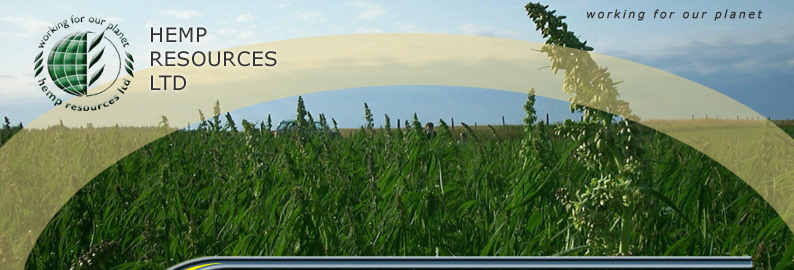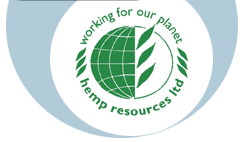





Back to What's New
May
2006 (Article)
Industrial Hemp allows forest to have a breather by Tian Xin
View document in
PDF Format.
Since
U.S Deportment of Agriculture (USDA) has carried out extensive researches
on kenaf as a potential source of raw material for papermaking in 1960S,
It has identified that Kenaf is a suitable substitute for the wood and
woodchip for papermaking.
Trials on chemi-mechanical pulping of kenaf on a mills scale were undertaken
in the United States in the 1987, it has been demonstrated that blends of 80%
kenaf chemi-thermomechanical pulp (CTMP) with 20% kraft pulp can produce commercial
grade newsprint, in which it is made by 80% CTMP pulp and 20% KP softwwod pulp,
printing out 72000 pieces of newspaper by the Press of Baker-field Californian
in U.S.A. These products were completely acceptable, which had high brightness
(64º), with less ink coverage and less linting. The results of trial have shown
that the printing-writing paper and tissue paper produced from softwood and
hardwood, which is suitable to be replaced by the whole kenaf stalks. The Phoenic
Paper Mill with a capacity of 70000T/yr, was set up in Thailand producing kenaf
market pulp. Some kenaf mills of papermaking also were built in China such
as in Yuanjiang county of Hunan, Wuzhi county of Henan, Miquan of Xinjiang,
Yucheng and Jining of Shandong provinces, pengshui of Chongqing city in the
past years. They used kenaf as raw material for papermaking with a capacity
of over 10000T/yr, nevertheless, their production scale is not so large, output
is not so much, why is it so?
In China kenaf is currently used on a limited scale in pulp and papermaking by pulping the whole stalk generally with other fibers raw materials.
(1) Kenaf is highly desirable as a raw material for pulping and paper because
of its low lignin content and high cellulose content. But, the most suitable
planting conditions for kenaf is limited, which grows well in the suitable
temperature and climatic conditions at 22?30? at day, 18?23? at night,
frost-free period at least 150 day, average relative humidity 68?82%, rainfall
distribution well at growth phase, the smooth of land, deep-level discharge
of water, fat sandy soils.
(2) The growing method for kenaf is that the seeds of kenaf is bred in the
South of China and cultivated in the North of China, they are often not seeded
with harvests, the economic profits of kenaf’s seeds seeded also is lower
and the income of kenaf stem is too less than that of planting corn crops in
China, growing cassava in Thailand. In addition, kenaf contains a great amount
of pith, its moisture content is too high to dry and therefore it is too difficult
to storage compared to general straw material, causing the kenaf stem to deteriorate
easily, when the bast fiber and stem are separated, the outside epidermis become
black, which brings some troubles for cutting and bleaching, it will affect
the quality of products, after the kenaf crop is harvested for 25 day and put
on the fields for 7 day (about 17?).
Although some achievements has been obtained to replace wood for papermaking
by kenaf, but the development is too slow to be able to make considerable
progress.
The industrial hemp is a suitable raw material for papermaking. It is used
for papermaking to have a high economic value and possibility comparing to
kenaf.
Shenyang Chengjian-Tongxin Intelligent Engineering Co. Ltd that grew plant
industrial hemp about 1000 Mu in Liaoning province in 1999, whole kenaf stalks
became black and mildewed while the whole kenaf stem and whole hemp stem were
put into the room at the same time for seven day at 17?, and the whole hemp
stalks had no mildew. The seed output of per Mu 30?70kg, which is over that
of kenaf, the THC contents of hemp seeds 0.00027%, conforming to the demand
of international market. The price of seed exporting was 1?1.5U.S dollar $/Per
kg. It only correspond to the income of growing corn crop, the output of whole
hemp stem/Per Mu was 700?1100kg. The selling price of it was 45 U.S dollars/Per
Ton, which may be sold to paper mill.
The farmers of growing hemp would increase their income of economy. It is more
important to suitable for papermaking in morphology of hemp fiber. Average
fiber from the bast portion of the stem are about 16mm long, the size of softwood
fiber only 3mm, while those from the core fiber are shorter, about 0.54mm long
and resemble hardwood fibers, the whole hemp stalks are correspond to proper
proportion of long and short fiber, suitable to papermaking.
The quality of pulp made from the bast of hemp is superior to the softwood
pulp, the core pulp is similar to hardwood pulp, the whole hemp pulp is
close to the mixtures of softwood and hardwood pulp, which is suitable
for papermaking.
The chemical components of hemp are more suitable to papermaking, its cellulose
contents for hemp 51.32% (softwood 50.86%), which has a high yields of
pulp and low contents of lignin 14.97% (softwood 27.85), so that it is
easy to cooking and bleaching with lowest content of dioxins produced when
lignin reacts with chlorine in bleaching. Pentosan content of hemp 18.29%,
which is high than that of 11.12% of softwood, low to than below 24.25%
of hardwood, 25.56% of wheat straw, 22.46% of reed. It is suitable to beat
for fiber due to be easy of swollen cellulose, ash content 2.24% is far
below 6.04% of wheat straw, 15.5% of rice straw, low ash which is suitable
to alkaline recovery like softwood red pine, facilitating the implement
of environment protection engineering and wastewater discharge.
Shenyang Tonxin Intelligent Engineering Co. Ltd, grew the varity of Dabaipi
of Hebei for three years, the average output of seeds per Mu was 45kg while
the average output of its whole stem per Mu were 800kg, it allowed the
hemp farmers to increase income for over 100 Yuan RMB/Per Mu, compairing
to grow corn.
After the harvesting of hemp, which was put on the land for over a month, its
content of water may be decreased to below 20%,without mildewing as that
of kenaf, this is helpful to produce white paper.
All experiments including the bast, core and whole hemp stem were carried out
separately in cooking, bleaching, beating and papermaking, by the Shenyang
Natural Fiber Research Institute. The test of paper was finished by the
Paper Quality Supervising and Testing Station of Shenyang of China State
Light Industry Bureau, the results show that, the quality of pulp made
from bast is superior to wood pulp.
The water pollution of pulp and paper mills is serious and it was considered
that spent cooking liquors are causing severe pollution. The pollution load
amounts to 85% of COD, BOD and SS. The research and actual measurements in
recent years indicated that we must understand clearly that spent bleaching
liquor has more harmfulness than black liquor and it’s toxicity is very
high.
In the end of 80s, the developed countries such as SWEDEN, FINLAND, NORWAY,
USA, CANADA, etc, which discovered and measured dioxins from bleach plant
effluent and sludge which caused cancer, break and monster characteristics,
having procreation and incretion toxicity and restraining immunity function
affecting hormone secretion, making man female, affecting children’s
growth and development, and causing cerebral nerve pathological changes
and acute toxicity disease.
Dioxins (TCDD) have most severe toxicity, which corresponds to 1000 times of
Potassium cyanide or over 500 times of strychnine.
During the period of June 1999 in Belgium and other countries, dioxins pollution
event took place in succession from the products of domestic animal and
birds and dairy products. The results shocked the whole world making consumers
panic to some extent, because of the high content of dioxins.
The dioxin is severe toxicity matter, which is difficult to degrade. Its half-life
is 7 years and remaining time in soil is 10 years. As biologic narcotics
continue the accumulation in circumstance, aquatic organism and body, it
is possible that it causes cancer as time bomb. When it accumulates to
certain degree, it makes people panic to oppose utmost the use of bleaching
agent-contained chlorine.
Some newspapers condemned paper mills as title “why are you making paper
so white”, forming environment pollution and harming aquatic organism
and human health.
At present, incidence of cancer?cardiovascular and cerobrovascular disease?diabetes?deficiency
of kidney-qi?children dysplasia?deformity is high and it is difficult to determine
the mechanism of happening cancer. The chlorine containing bleaching at paper
mills has become the focus of public opinion by numerous people.
In addition, paper is closely related to people’s life. Especially packaging
foodstuff and drinks, for example, milk to paper box was examined in U.S.A
and it contained 0.04ppt dioxins. It was discovered that dioxins dissolved
from bleached pulp, which exceeded safety standards (The content of dioxins
of pure water standard must be under 0.000013ppt by U.S.A Environmental Protection
Bureau.) The demand of sanitation in the products of bleached filter paper
and filter board, which filtrate blood, water, drinks, alcohol and oil is very
strict. This is why we must produce pulp, paper and paperboard without dioxins.
World papermaking raw materials amount to 92% of wood, in which a vast majority
is made by sulfate process. The bleaching sequence is (4-7) stage, using chlorine
as bleaching agent, because it is more difficult to bleach without chlorine.
According to a report of Mr. Yangmao Xian, Vice Director of China Paper Technical
Association, ECF (Elemental Chlorine Free) and TCF (Total Chlorine Free) bleached
pulp and paper have been welcomed universally in Europe.
Another article states that world pulp market has a tendency of requirement
for pulp without any chlorine containing bleaching agent. Although the
discharge amount of spent bleaching liquor AOX in which Cl2 is replaced
by ClO2 by 100%, descends to lower, Especially countries which imported
bleached pulp like Germany, Switzerland, Austria, and Holland, are claiming
that their requirements for the imported pulp is more strict (stringent).
Today, with regulatory issues in the U.S., Europe and Asia settled, the competition
between pulp bleaching methods has moved to building markets for various
products. Some environmental groups and other advocates claim that TCF
bleaching is environmentally superior to ECF and are encouraging consumers
who use bleached paper and board to purchase products made from TCF pulp.
TCF bleached pulp and paper are green products of environmental protection,
which are favoured all over the world. In recent years, many companies
at home and abroad have been carrying out TCF bleaching research work.
Many publication have made related reporting.
According to a report of Mr, Yangmaoxian, senior engineer of professor class,
Vice Director of China Paper Technical Association, “The Proceedings
of the Sixth Annual Meeting of Peking Paper Making Association in February,
1999”. He said that ECF and TCF bleached pulp and paper have been
welcomed universally in Europe.
Another technical publication “Paper and Papermaking” on page 7,
No.2, 1994. It is stated that world pulp market had a tendency of requirement
for pulp without any containing chlorine bleaching agent. Although the discharge
amount of spent bleaching liquor AOX in which Cl2 is replaced by 100% chlorine
dioxide substitution, descends to lower.
Especially some countries which imported pulp like Germany, Switzerland, Austria
and Holland are claiming that their requirements for the imported pulp
is more strict.
It was reported that Japan papermaking industry is planning to use chemicals
without containing chlorine for 13 paper mill in 2005, because the chlorine
compounds will produce dioxins and other harmful substances.
According to a report of “The Chem Engineer” No.7, 2000. It was
said that a great challenge of the early 1990s impelled the papermaking industry
to rethinking for stimulating development of TCF bleaching sequence. The development
of process has changed greatly the appearance of chemical pulp mills and it
was also economic without environmental impacts until 2003, the production
of ECF and TCF bleached pulp will be 75% of all pulp production.
With the increasing of awareness of environmental protection, the market prospect
is very wide more and more.
China’s Pulp and Paper Industry is basically grounded on non-wood fiber
plant, using 86% non-wood fibers. Non-wood fibers are high in ash content,
rich in pentosan compared to coniferous wood. In addition, due to its low-lignin
content, the brown pulp of cooking is light color, which is easy to carry out
TCF bleaching, unbleached chemical pulps are too dark in color for use in the
manufacture of high-grade white papers, the dark color is derived mainly from
the lignin in the pulp.
In modern mills, oxygen is normally used in the first stage of bleaching, the
trend is to avoid the use of any kind of chlorine chemicals and employ
total chlorine free bleaching (TCF), TCF processes allow the bleaching
effluents to be fed to the recovery boiler for steam generation, bleaching
wastewater and products have no dioxins.
China was the earliest country to grow hemp in the world, the bast fiber plants
(hemp) had been planted in vast areas in China for a very long time and
much experience has been accumulated in China.
The THC content of industrial hemp is 0.00027 percent, conforming the quality
requirement of international markets according to the report of test by the
world hemp centre.
We think that the pulping of non-wood and TCF bleaching also will have a bright
future in international markets.
According to fifth national inventory of forest resources, present forest area
of China is 1.589 (100 million hectares), (The forest area of per kapita)
is 1/6 of world mean number, the forest growing stock is 112.7 (100 million
cubic metre), the stock volume of the forest of per kapita (1/8 of world
average number) the forest-coverage rate increased from 12.7% to 16.55%,
through many years efforts of the whole nation from the leadship to the
masses, which correspondents only to 61.3% of world forest coverage rate
for average number. China is a less forest country, which has not enough
total amount of forest, un-uniform distribution of forest and the mature
stand, over mature forest only accounts for 14%, forest growing stock account
for 38% and most forest constitute of nature forests, which is located
in important regions of ecological position, which can not be harvested
and used (exploited), the consumption of forest resources for all national
average over restrained limit cutting comparing to the same category of
forest limit cutting approved by the State Council, which has reached 86.00
million cu meter. Due to nature forests to be deforested, it lead to serious
flood catastrophe in North and South of China in 1998. So that, the State
Council published an order, calling for strictly forbidding cutting nature
forest in the future some years therefore it is necessary to import wood
years from other countries.
At present, the annual demands of commercial wood in China is about 100 million
cu meter, actual supply was 50 million cu meter, shortage of wood reached a
half of them. The annual mean imports of wood was 45.80 million cu meter, only
the expenditure of foreign exchange in 1998 had reached 6.34 billion U.S. dollar
$, so appealing for the nation to supply sufficient wood and wood chip to the
paper industry. It is limited to expand the proportion of wood, due to the
shortage of wood resources, in order to expand use of wood, there are needs
of implementing a policy of integration between forestry and paper, the large
scale-size paper mills must set up raw materials base for papermaking. But,
today even if paper industry has had its raw material base for papermaking,
the southern eucalyptus and Acacia of China in the breeding rotation of it
and other hardwood that need 6 years, Caribbean pine, Masson’s pine and
other softwood need 12 years, hardwood such as Daqing poplar?Tian poplar?poplar
need 15 years in North of China, Xingan larch, Korean larch, Japanese larch
etc, softwood which need 25 years. The triploid white poplar in middled and
lower regions of Huang river, need 8 years and even if fast growing forest
also need around 5 years, the consumption of paper of China and output of paper
increased year by year, it is impossible to wait trees to grow up, but by large
cutting Young-middled aged forest, the reserve resources will be destructed
and make it to have serious consequences.
So that, if the paper enterprises in China is to live and develop, it must
undergo self-imposed hardship so as to strengthen one’s resolve to
wipe out a national humiliation, implementing the integration of forestry
and paper, building forestry bases.
From 2005, China’s paper industry will speed up the integration between
forestation and papermaking and that between capital operation and industrial
operation through these integrations, the fittest would survive and the competitions
of China’s paper industry would be elevated.
 |
||
 |
 |
 |
|
|
||
|
|
||
|
|
||
|
|
||
|
|
||
|
|
||
|
|
||
 |
 |
|